Posting trot can be a really beneficial for horse and rider. Despite its popularity, many of us find ourselves struggling to post correctly or with good rhythm. Here are some tips to help improve your posting trot technique.
Why posting trot?
The posting trot has specific purposes, pros, and cons just as sitting trot does.
Posting Trot Pros
The following are some specific reasons to use posting trot:
- Young Horses – to reduce the amount of work they have to do at the trot and minimize stress to their back.
- Conditioning – working at a faster pace of the trot than is able to be ridden in sitting trot.
- Long Distances – and large periods of trot work to again reduce the amount of work the horse must do; and the rider as well.
- Rehabbing – horses who have issues with their gaits, balance and suppleness the posting trot can help reduce their work load while they develop in these other areas.
- Jumping – work over varying sizes of rails brings you closer to 2-point position.
Posting Trot Cons
The following are some specific reasons not to use posting trot and instead use sitting trot:
- When riding horses who are spooky or may pose a higher risk to their rider, posting trot can make you more vulnerable in the saddle and increase your risk of a fall. Use with caution in these cases.
- If you're using it in place of developing your skills in sitting trot. The longer you put off improving your seat at sitting trot, the harder it will be to improve!
Posting The Trot Phases
There are two phases in posting trot:
- The Rise Phase, when your seat is physically out of the saddle.
- The Sitting Phase, when your seat is physically in the saddle.
I'll refer to these two phases throughout this article.
How to correctly post the trot
Believe it or not, the posting trot can be very easy once you have the technique down.
The horse should do most of the work for you, but it is important that you are in the correct position and riding in the proper equipment if you expect to post the trot for more than a circuit or two around the arena comfortably and safely.
Your Riding Equipment
The saddle you ride in while practicing posting trot can be highly influential in your success.
Any saddle which promotes a long leg, like a Dressage saddle, will make posting more of a challenge.
If you are just beginning, or really struggling to get the technique down, try using a saddle with a more forward flap, like a cross-country or jumping saddle.
Your Position
Your leg should be positioned to act like a lever.
Good Posting Trot Example:
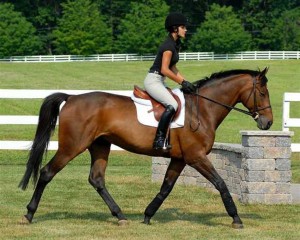
Bad Posting Trot Example:
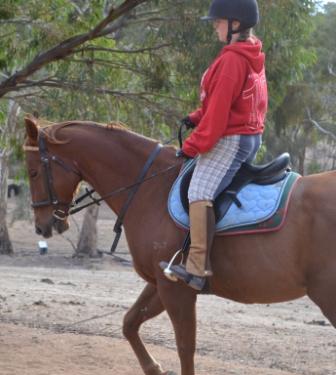
Your Horse's Trot Speed
Even the speed at which your horse is trotting can significantly affect your success in posting the trot. This will become less of a factor over time once you build your skill at posting the trot, however, in the beginning, it's helpful to know how the speed your horse is trotting at will impact posting the trot.
- Trotting Too Slow
When your horse is trotting too slowly, you'll work very hard to push yourself out of the saddle for the rise phase. It will be very easy to control your movement back into the sitting phase, so for many riders, they prefer this speed because they feel more in control.
The trade-off for feeling in control by trotting too slowly is that you expend a lot of physical energy and are unable to properly develop your horse's gait. - Trotting Just Right
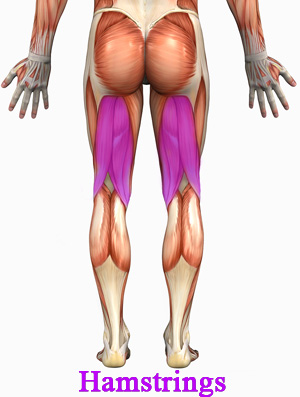
You should be using your hamstring muscles when posting the trot to pull yourself back into the saddle for the sitting phase. When your horse is trotting just right, you're going to feel like you are being launched out of the saddle during the rise phase. This is good!
You will likely feel uncomfortable at this, because we are typically taught that we should push ourselves out of the saddle for the rise phase. Fight against this bad habit, and instead let the horse do the hard work of pushing you out of the saddle for the rise phase.
All you need to be responsible for is the sitting phase, pulling yourself back down into the saddle using your hamstring muscles.
My Own Challenges With Posting the Trot
I want to relay some of the areas I struggled with through my own learning curve, as well as those which I have helped my students to overcome since – in hopes that they may be useful for you too.
My initial education in posting the trot is vague at best. There were some lunge lessons at a very young age and group lessons where we practiced posting the trot. What is certainly sealed into my memory of those times is just my sheer horror at riding on the lunge without stirrups and reins, and in the group lessons was riding large horses who I was not terribly comfortable with and having to (in my mind) stand up and sit down in the saddle without falling off because of their big scary trot.
The reformation of my posting trot skills did not come for some time. Even my traditional Dressage instructors did nothing to address the horror that could only describe my posting the trot. I was given the chance to learn to sit the trot properly for the first time through intensive lunge work and seat lessons. Following sitting trot, I properly learned how to post the trot without stirrups.
I was terribly off in my timing and behind the motion of the horse which meant I kept falling back into the saddle and admonished terribly for the pain I must be causing to my horse's back. I improved, but the big turning point came largely with jumping lessons where we would warm up at the posting trot, still without stirrups, for half an hour. practice
We practiced lengthening the trot on the long side of the arena and shortening on the short side, round and round and round. My calves have never experienced such pain!
The results were well worth it though and over time posting the trot became second nature. Some things I learned in the process however, which were not always explained to me plainly and clearly included the following –
- The posting trot is done with the Hamstring Muscles, NOT the Quadriceps.
Your hamstrings are on the back of your thigh, the quadriceps on the front. Your quads help you rise out of the saddle and the hamstrings pull you back into the saddle. Often when we start posting the trot we're taught, and feel the need, to push ourselves out of the saddle for the rise phase. But the horse's trot should push us out if we are in the proper body position for posting the trot. From there the only work we need to do is to bring our butt back to home base. The key here is being in the proper body position which includes your upper and lower body. - Your lower legs must find the widest part of the horse's barrel.
We can have a tendency to allow our lower legs to sit forward from underneath us, rather than bringing them back underneath us. This is true whether we are sitting or posting the trot. Most riders find themselves defaulting to riding with their lower leg hanging straight below or slightly in front of the knee. In order for the hamstrings to be effective in bringing us back to the saddle when posting the trot, our lower leg has to be behind the knee and under the mass of our body during the sitting phase. To create a solid leg position, pull your lower leg back along the horse's body until it naturally stops against the widest part of the horse's barrel. This position stabilizes the lower leg so it will no longer be moving forwards and backwards with every posting stride. - The knees have to be relaxed.
If you are pinching with your knees in the posting trot it pushes your lower leg away from the side of the horse and restricts your ability to bring your body back down to the saddle while posting the trot. A great way to combat this is to practice opening your knees away from the sides of the horse when the horse pushes you out of the saddle during the rise phase. - Stirrups are not for pushing against.
This is very common – riders using the stirrups as a means to push themselves out of the saddle in posting the trot. The best solution for this issue is to post the trot without stirrups altogether, an exercise I recommend regardless as it reveals any weaknesses or imbalances in your position, posting timing and rhythm and any tension in your legs. - Stirrups can be a crutch.
If you've ever lost a stirrup (had your foot come out of the stirrup) while posting the trot this is precisely what I am addressing. What did you feel or experience when that happened? Were you off balance, out of sync, feeling panic as you tried desperately to find the stirrup with your foot again? Did you have to bring your horse to a walk or halt in order to regain your stirrup and your position in the saddle before resuming? This is a sure sign that you are using your stirrups as a crutch for balance and this is dangerous in posting the trot. It's also an indicator that you're still pushing yourself out of the saddle for the rise phase. Practice posting the trot without stirrups and once you are confident with that, practice posting with stirrups while you drop them at the same time and separately and pick them back up again without losing your timing, position, and balance.
I'm set for my journey back into posting trot work and invite you to join with me! I'll be practicing all of these tactics to keep improving myself and catch any bad habits that may creep up before they have a chance to become ingrained.
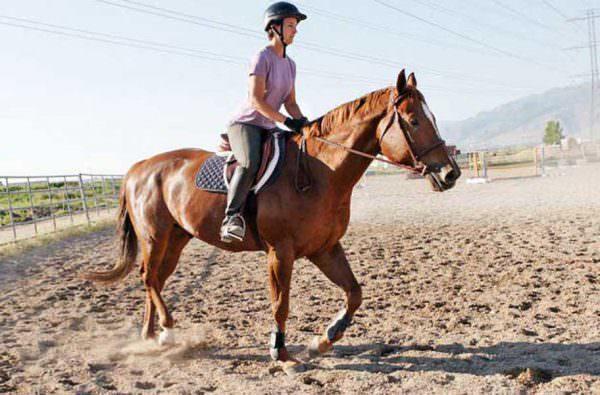

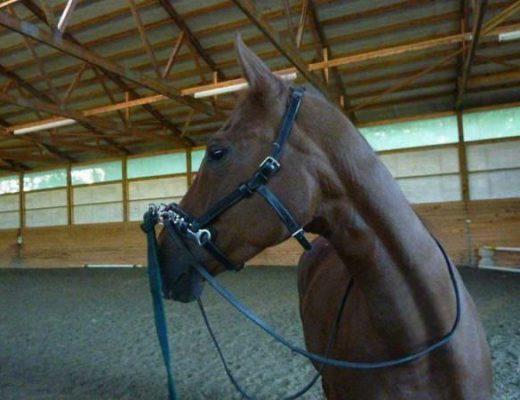
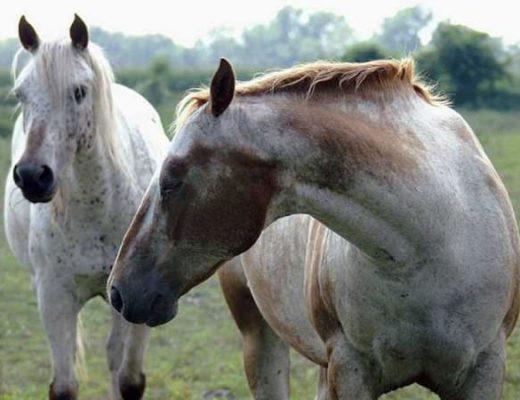
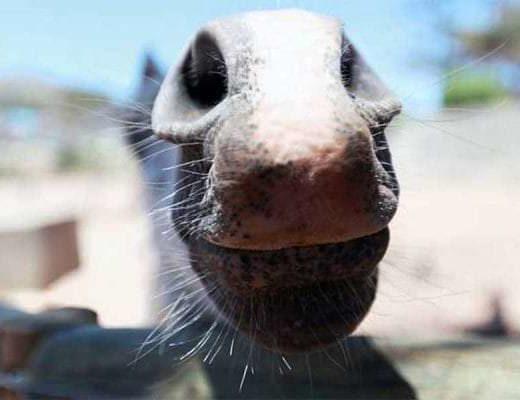
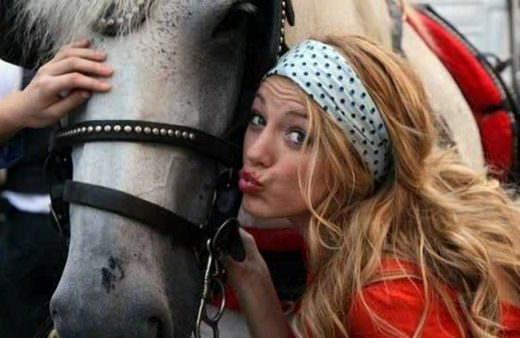
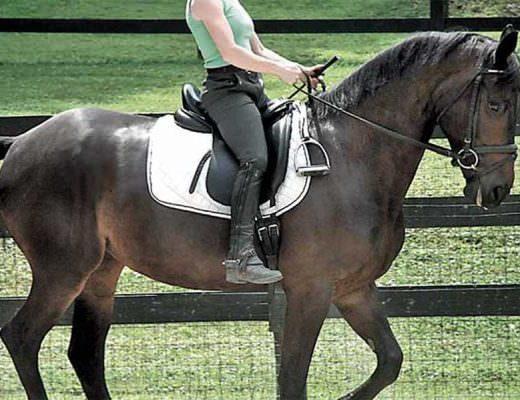
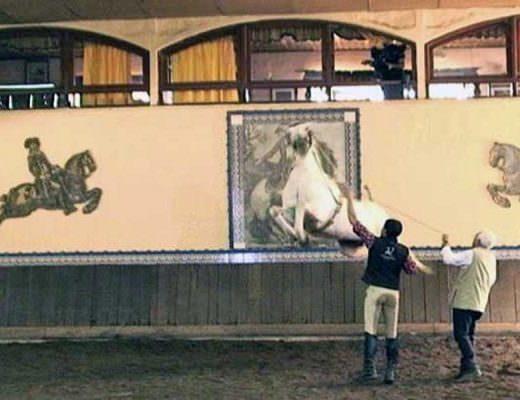
Thank you so much for this post, just today I had my first ever English riding lessons and I could not understand at all what they were trying to tell me with how to post, because I couldn’t keep my balance at all until the last try when I was actually close to decent. I will keep trying, despite the pain I’ll wake up with the next day!
Thanks for this post! I’m going to be doing horse camp in July, and I needed to refresh my posting skills. This really helped!
I just started horse riding and have been feeling so lost when it comes to posting the trot, so thank you so much for writing this guide!! It will be helpful. I’m doing a lot of things wrong apparently—depending on stirrups, pushing myself out of the saddle instead of letting the horse do it naturally, tightening my knees etc. hehe so I think you’ve saved some frustration for both me and my instructor with this guide. I don’t doubt it’ll still take me some effort before I can post the trot successfully, but at least now I have a clearer idea of what I’m doing wrong.
Its really an informative post! Thanks for sharing